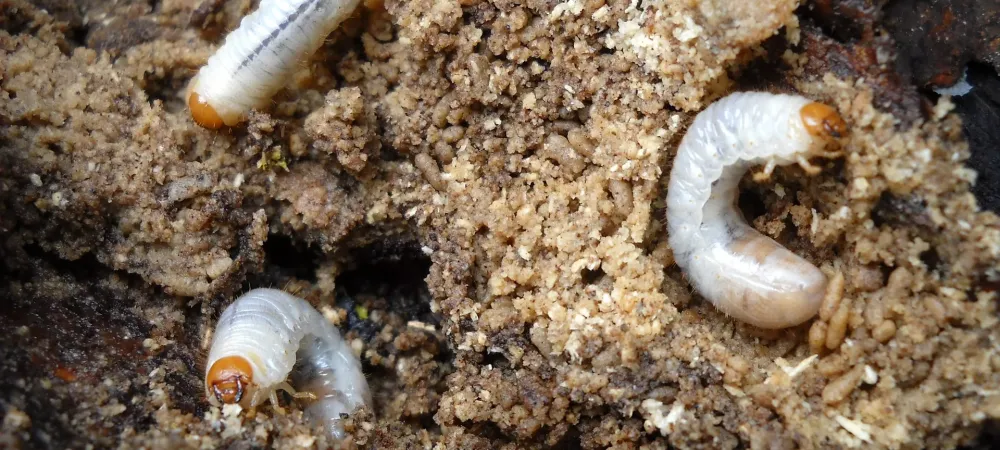What Are Grubs And How To Get Rid of Them

Unlike other common lawn pests, grubs spend their days beneath the surface of the soil, where you likely won’t notice them until your lawn has severe damage. And now that spring is upon us, grubs will awaken from their winter slumber and begin feasting on your grass. That’s why we’d like to teach you how to identify them and implement grub control.
What are Grubs?
Lawn grubs, also known as white grubs, are the larvae of Japanese beetles or June bugs. Grubs generally have c-shaped bodies with brown heads, visible legs, and are about 1/8 to one inch long.
These beetles mature from their larvae stage in late spring and early summer to feed on your trees and shrubs at night. They return to the ground to lay their eggs, all but ensuring a bigger infestation next year. When the grubs hatch, they immediately start feeding on the roots on your grass and can cause extensive turf damage.
Finding a few grubs here and there is normal but when there are dozens within one square foot, then your lawn is probably already showing the signs of a grub infestation.
Signs You Have Grubs
Here are a few things you may notice if you have a grub infestation in your yard:
Increase In Animal Activity
You might think grubs are gross, but for many animals, grubs are a delicacy. If you notice more birds, possums, raccoons, or skunks than usual, it could be a sign of grub activity. These critters will tear up your turf in the search for a tasty treat, leaving you with lawn damage.
Damage To Turfgrass Roots
As grubs chew on the roots of the grass, the blades above the surface will start to brown, wilt, and die off, creating undesirable dead or brown patches in your lawn. Many homeowners mistake dead or dying grass for lack of moisture or nutrients. If you’ve tried extra watering and fertilizer, and things still look damaged, it could be a sign of grubs.
Keep in mind that grub damage often has multiple symptoms, so if you have thinning grass, don’t panic immediately. If you notice dead grass in conjunction with the other signs we discuss, it could be time to consider grub treatment.
Turf Is Loose Or Uneven
If you notice a divet in your lawn that wasn’t there before, it could be caused by grub activity beneath the surface. Spongy grass is another common red flag. While well-watered grass should feel soft, if you feel like you’re walking on a foam mat, that’s not a good sign. Or your grass could become loose and can be rolled back easily like sod. If you can do this, you should see the grubs in the soil as you peel back the grass.
How To Get Rid Of Grubs
Like all insects, it’s impossible to eradicate the population completely. Having some grubs on your lawn does not mean the end of the world. However, 10 or more per square foot is when you’ll start to notice the damage. There are several ways of keeping grubs under control:
- Keep your lawn well-fertilized and keep the mower height between 2 and 3 inches. This promotes a healthy root system, which is less prone to grub infestation.
- Treat dead or dying areas with an overseeding application to restore damaged areas, and discourage more beetles from attacking the already stressed grass.
- Apply an insecticide. What you use depends on the time of year you’re applying it. Products with imidacloprid, thiamethoxam, and clothianidin are good as preventative measures, while Ingredients such as carbaryl, trichlorfon, or zeta-cypermethrin are better for late summer and early fall. Be sure to ask your lawn care professional.
Call the Professionals
There’s no need to put up with destructive insects on your lawn. The experts at Showcase Lawn Care are here to help! Our grub control program effectively eliminates these annoying bugs so your grass can thrive and grow undisturbed. Give us a call today at (763) 415-7383 or contact us online for a free estimate!
FAQ about Lawn Grubs
Here are some of the most common questions our technicians get about white grubs:
What is a Grub?
A grub is the common name for the larval stage of certain insects, particularly beetles, belonging to the order Coleoptera. Grubs are soft-bodied, white or cream-colored, and usually have a distinct C-shaped appearance. They lack legs, have a well-developed head capsule, and their bodies are segmented.
Grubs typically live in the soil or other decaying organic matter, where they feed voraciously on plant roots, decomposing plant material, or other organic matter. Some well-known examples of grubs include the larvae of Japanese beetles, June beetles, European chafer beetles, and masked chafer beetles.
What are Signs of Grub Damage to Your Lawn?
Signs of grub damage to your lawn include:
- Wilting Grass: Affected areas of the lawn may begin to wilt and show signs of dehydration, even when well-watered.
- Brown Patches: Irregularly shaped brown or dead patches may appear on the lawn, indicating areas where the grubs have been feeding on the grassroots.
- Loose Turf: The turf may become loose and easily detachable, almost like it can be rolled back like a carpet, as the grubs feed on the grassroots, undermining the stability of the turf.
- Increased Presence of Birds, Raccoons, and Skunks: These animals are known to feed on grubs, so an increase in their activity on your lawn could be a sign of a grub infestation.
- Spongy or Squishy Lawn: Walking on the affected areas of the lawn may feel spongy or squishy, indicating damage to the root system.
- Visible Grubs: You might find white C-shaped larvae (grubs) in the soil when digging around the affected areas, especially in late summer or early autumn.
If you notice these signs, it's essential to take action to address the grub infestation and prevent further damage to your lawn.
Can my Lawn Recover from Grub Damage?
Your lawn can recover from grub damage, but the extent of recovery depends on several factors, including the severity of the grub damage, the type of grass, the time of year, and the steps taken to address the grub infestation and aid in the recovery process.
If the grub infestation is relatively mild and detected early, the lawn stands a better chance of recovery. In such cases, the grass can rebound on its own with the right conditions, such as proper watering, fertilization, and regular mowing. Additionally, if the grubs are eliminated or their population is reduced through natural control methods or insecticides, the grass can start to recover as the root system regains strength.
However, if the grub infestation is severe and has been ongoing for an extended period, the damage to the lawn may be more extensive. Large areas of dead or weakened grass may require reseeding or overseeding to promote new growth. In severe cases, it might be necessary to completely reestablish the lawn using sod or laying down new grass seed.
